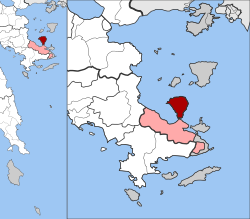
The Saronic Gulf or Gulf of Aegina in Greece is formed between the peninsulas of Attica and Argolis and forms part of the Aegean Sea. It defines the eastern side of the isthmus of Corinth, being the eastern terminus of the Corinth Canal, which cuts across the isthmus. The Saronic Islands in the gulf have played a pivotal role in the history of Greece, with the largest, Salamis being the location of a significant naval battle in the Greco-Persian wars. The Megara Gulf makes up the northern end of the Saronic Gulf.
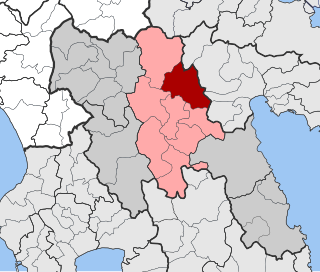
Mantineia was a city in ancient Arcadia, Greece, which was the site of two significant battles in Classical Greek history.

Poros is a small Greek island-pair in the southern part of the Saronic Gulf, about 58 km south of the port of Piraeus and separated from the Peloponnese by a 200 m (656 ft) wide sea channel, with the town of Galatas on the mainland across the strait. Its surface area is about 31 square kilometres (12 sq mi) and it has 3,261 inhabitants (2021). The ancient name of Poros was Pogon. Like other ports in the Saronic, it is a popular weekend destination for Athenian travellers.

Attica, or the Attic Peninsula, is a historical region that encompasses the entire Athens metropolitan area, which consists of the city of Athens, the capital of Greece and the core city of the metropolitan area, as well as its surrounding suburban cities and towns. It is a peninsula projecting into the Aegean Sea, bordering on Boeotia to the north and Megaris to the west. The southern tip of the peninsula, known as Laurion, was an important mining region.

Kythira, also transliterated as Cythera, Kythera and Kithira, is an island in Greece lying opposite the south-eastern tip of the Peloponnese peninsula. It is traditionally listed as one of the seven main Ionian Islands, although it is distant from the main group. Administratively, it belongs to the Islands regional unit, which is part of the Attica region, despite its distance from the Saronic Islands, around which the rest of Attica is centered. As a municipality, it includes the island of Antikythera to the south.
Agios Nikolaos is the Greek name of St Nicholas. As a place name, it may refer to:
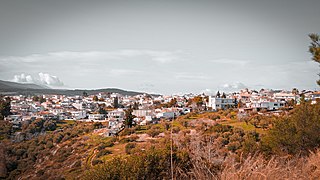
Tanagra is a town and a municipality north of Athens in Boeotia, Greece. The seat of the municipality is the town Schimatari. It is not far from Thebes, and it was noted in antiquity for the figurines named after it. The Tanagra figurines were a mass-produced, mold-cast and fired type of Greek terracotta figurine produced from the later fourth century BC, primarily in Tanagra.

Megalochori is a village and a community in the western part of the volcanic Methana peninsula, Greece. It is located 3 km northwest of Methana town. The community consists of the villages Megalochori, Vathy, Kaimeni Chora and Megalo Potami. The ancient Acropolis of Methana, which was described by Pausanias, is located near Megalochori.
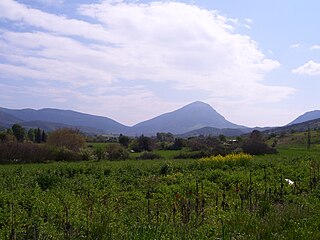
Troezen is a small town and a former municipality in the northeastern Peloponnese, Greece, on the Argolid Peninsula. Since the 2011 local government reform it is part of the municipality Troizinia-Methana, of which it is a municipal unit. It is part of the Islands regional unit. Population 4,668 (2021).

Piraeus Prefecture was one of the prefectures of Greece. Created in 1964 as a separate Prefecture (Νομός) and after the dissolution of the prefecture in 1972 was one of the 4 prefectures (Νομαρχίες) of Attica prefecture, and from 1994, part of the Athens-Piraeus super-prefecture (1994–2011). The capital of the prefecture was Piraeus. As a part of the 2011 Kallikratis government reform, the prefecture was abolished, and its territory was divided into two regional units: Islands and Piraeus.

The Methana volcano peninsula is situated approximately 50 kilometres (31 mi) southwest of Athens in Greece.

Ano Fanari is a mountain village belonging to the Troizinia-Methana municipality in northeastern Peloponnese, Greece. A small acropolis rises above Ano Fanari. It is situated on the old road from Galatas to Agia Eleni and Epidavros.

Kounoupitsa is a village and a community in the northern end of the Methana peninsula, northeastern Peloponnese, Greece. It is part of the municipality Troizinia-Methana. The community consists of the villages Kounoupitsa, Agios Georgios, Agios Nikolaos, Makrylongos and Palaia Loutra. The population of the community at the 2021 census was 128. Agios Nikolaos is known for its volcanic hot springs.

The Acropolis of ancient Methana is located 1 km from the town of Megalochori in the volcanic peninsula of Methana.
The First Peloponnesian War was fought between Sparta as the leaders of the Peloponnesian League and Sparta's other allies, most notably Thebes, and the Delian League led by Athens with support from Argos. This war consisted of a series of conflicts and minor wars, such as the Second Sacred War. There were several causes for the war including the building of the Athenian long walls, Megara's defection and the envy and concern felt by Sparta at the growth of the Athenian Empire.
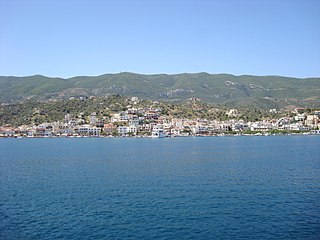
Galatas, is a town located in the eastern part of the Peloponnese peninsula, Greece. It is the seat of the municipality of Troizinia-Methana, which belongs to the Islands regional unit. It is situated on the coast, opposite the island Poros, across a 400 m (1312 ft) wide strait. The community Galatas consists of the main town Galatas and the villages Agia Sotira, Vlachaiika and Saronida.

The Islands Regional Unit is one of the regional units of Greece. It is part of the region of Attica. The regional unit covers the Saronic Islands, a small part of the Peloponnese peninsula, and a few islands off the eastern Peloponnese coast.

Troizinia-Methana is a municipality in the Islands regional unit, Attica, Greece. The seat of the municipality is the town Galatas.

Nisaea or Nisaia was the Saronic port town of the ancient polis Megara. In Greek mythology, Nisaea was founded by one of Pandion II's sons, Nisos, who named the region given to him by his father Nisaea, after himself. Control of Nisaea slipped back and forth between Athens and Megara both before and during the Peloponessian War. Athenian allies of the Megarians built long walls which connected Nisaea to Megaris. According to Thucydides, the length of the walls that connected the port to Megara were eight Greek stadia, while Strabo claims the walls to have been 18 stadia in length. A temple of Demeter was located on the road near Nisaea, and a temple of Poseidon located within the port town. Nisaean Megara is thought to have been the birthplace of poet Theognis, but his birthplace is not known for certain The location of the ancient port town remains in debate by historians.


